|
|
|
Sort Order |
|
|
|
Items / Page
|
|
|
|
|
|
|
| Srl | Item |
| 1 |
ID:
145587
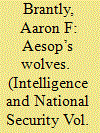

|
|
|
|
|
| Summary/Abstract |
Appearances in cyberspace are deceptive and problematic. Deception in the cyber domain poses an immensely difficult challenge for states to differentiate between espionage activities in cyberspace and cyber attacks. The inability to distinguish between cyber activities places US cyber infrastructure in a perilous position and increases the possibility of a disproportionate or inadequate response to cyber incidents. This paper uses case analysis to examine the characteristics associated with the tools and decisions related to cyber espionage and cyber attacks to develop a framework for distinction leveraging epidemiological models for combating disease.
|
|
|
|
|
|
|
|
|
|
|
|
|
|
|
|
| 2 |
ID:
083229
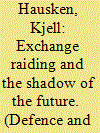

|
|
|
|
|
| Publication |
2008.
|
| Summary/Abstract |
Abstract A two-period exchange model is developed where production decisions in the first period determine the amount of resources available in the second period. Each agent allocates resources to defend its production and attack the production of the other agent. Production, conflict and exchange occur simultaneously in a dynamic model. This extends earlier exchange models, which are static and preclude defense and appropriation. The agents jointly determine price through their export decisions. Upon introducing exchange endogenously, raiding in the first relative to the second period decreases with growth, appropriation cost, and when the future becomes more important, and increases with defense cost, production cost, and usability of appropriation. Increasing the usability of appropriation and defense cost causes a transition from pure exchange via joint exchange and raiding to pure raiding. This implies that agents gradually substitute from defense to appropriation, they exchange less, and utility decreases. Utility isoquants in a usability of appropriation versus discount factor diagram are concavely increasing for joint exchange and raiding, and can be convexly decreasing for pure raiding. Cobb-Douglas utilities are assumed. The results are confirmed with CES utilities
|
|
|
|
|
|
|
|
|
|
|
|
|
|
|
|
| 3 |
ID:
126117


|
|
|
|
|
| Publication |
2012.
|
| Summary/Abstract |
A deliberate attack involving chemical, biological, radiological, or nuclear (CBRN) material has the potential to cause substantial fear among the public. This presents problems for communicators, who will need to provide information quickly after an attack while ensuring that their messages are easily understood and likely to be attended to by members of the public. Identifying in advance what people would want to know, where they would get information from, and how messages should be presented might allow communicators to ensure that their messages have the best chance of having their desired effect. In this review, we identified all peer-reviewed studies that have assessed communication strategies or information needs using hypothetical CBRN scenarios or in actual CBRN incidents. We identified 33 relevant studies. Their results support existing psychological models of why people engage in health protective behaviors, with information about the severity of the incident, the likelihood of being exposed, the efficacy and costs or risks of recommended behaviors, and the ability of individuals to perform recommended behaviors being sought by the public. Trust plays a crucial role in ensuring that people attend to messages. Finally, while a large variety of spokespeople and sources were identified as being turned to in the event of an incident, the use of multiple information sources was also common, affirming the importance of communicating a consistent message through multiple channels. Further research is required to extend these predominantly US-based findings to other countries and to confirm the findings of research using hypothetical scenarios.
|
|
|
|
|
|
|
|
|
|
|
|
|
|
|
|
| 4 |
ID:
189279
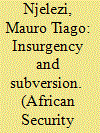

|
|
|
|
|
| Summary/Abstract |
Resulting from several social, political, economic and above all radical Islamic factors, the armed conflict in Cabo Delgado raised a variety of questions in the national and international system, among them the modus operandi of the group, now called Ahlu Sunnah Wa-Jammá. Thus, the present article analyses the way in which the modes of insurgency and subversion help to understand the modus operandi of the Ahlu Sunnah Wa-Jammá. For this purpose, a methodological study was established in which the semi-structured interview technique involved officers and documentary analysis for data collection. The results of the study show that the modus operandi of the Ahlu Sunnah Wa-Jammá is circumscribed to the organisation of numerous semi-autonomous cells which carry out guerrilla, terrorist and subversive actions. Furthermore, it was highlighted that the conflict was initiated by a minority of individuals subordinate to a radical religious ideology, and the objective of its operationalisation, until then, was carried out in three phases: preparatory, agitation and insurrection.
|
|
|
|
|
|
|
|
|
|
|
|
|
|
|
|
| 5 |
ID:
165357
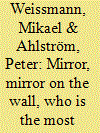

|
|
|
|
|
| Summary/Abstract |
This article explores why the offensive predominates military tactical thinking. With survey results showing an offensive bias among 60 per cent of senior Swedish officers and as many as 80 per cent in the case of the army, it is clear that this is not just a problem of the past but is equally relevant today. The article asks why there is a tendency to perceive and understand offensive tactics as the preferred choice and the way to conduct battle that should be encouraged and preferred. Drawing on existing research and the findings of a pilot study, ten propositions for why the offensive bias exists are tested using a mixed-method approach. Based on the findings, the article develops a model to understand why the offensive dominates military tactical thinking. It is found that the two key constitutive factors behind the offensive bias are military culture and education. These factors most directly and profoundly influence an officer’s identity, perceptions, and thinking. Military culture and education, in turn, work as a prism for four other factors: military history, the theory and principles of war, doctrine and TTPs, and psychological factors.
|
|
|
|
|
|
|
|
|
|
|
|
|
|
|
|
| 6 |
ID:
100058
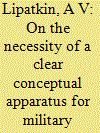

|
|
|
| 7 |
ID:
108297
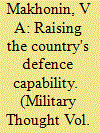

|
|
|
| 8 |
ID:
125130
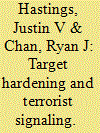

|
|
|
|
|
| Publication |
2013.
|
| Summary/Abstract |
In this article, we examine the relationship between hardening a target and the value that a terrorist group derives from attacking it. We use a simple expected value framework to compare how the expected value of attacking a hardened target varies between a violence-based approach, where terrorists are presumed to be maximizing the physical damage done to the target, and a signaling-based approach, where terrorists are presumed to be maximizing the symbolic value of their attack. We argue that, if it is proper to understand terrorist attacks as costly signals of terrorist strength or determination, hardening a target actually increases the expected value of attacking a target (relative to its value before hardening), even if the attack fails. We go on to examine the evolution of aviation security, and trace how al-Qaeda's views of airplanes and airports as targets have changed since 9/11. As aviation targets were hardened with increasingly onerous security measures, al-Qaeda began to see even attacks that did not result in detonation as successes, in large part because of what they signaled about al-Qaeda's abilities, and the ability of al-Qaeda to impose costs on the U.S. and other countries even in the absence of explosions.
|
|
|
|
|
|
|
|
|
|
|
|
|
|
|
|
| 9 |
ID:
108944
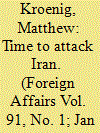

|
|
|
| 10 |
ID:
086512
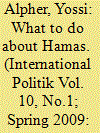

|
|
|
|
|
| Publication |
2009.
|
| Summary/Abstract |
Israel has an array of options besides reoccupying the Gaza Strip. One alternative is to open passages linking it to Gaza, ending the damaging economic blockade. Another is to seek direct talks with Hamas. Both are preferable to long-term occupation, which Israel would be hard-pressed to end cleanly.
|
|
|
|
|
|
|
|
|
|
|
|
|
|
|
|
|
|
|
|
|